JAVA NIO学习记录1-buffer和channel
Posted liunianfeiyu
tags:
篇首语:本文由小常识网(cha138.com)小编为大家整理,主要介绍了JAVA NIO学习记录1-buffer和channel相关的知识,希望对你有一定的参考价值。
什么是NIO?
Java NIO(New IO)是从Java 1.4版本开始引入的一个新的IO API,可以替代标准的Java IO API。NIO与原来的IO有同样的作用和目的,但是使用的方式完全不同,NIO支持面向缓冲区的、基于通道的IO操作。NIO将以更加高效的方式进行文件的读写操作。
Java NIO 与IO 的主要区别

Java NIO系统的核心在于:通道(Channel)和缓冲区(Buffer)。通道表示打开到IO 设备(例如:文件、套接字)的连接。若需要使用NIO 系统,需要获取用于连接IO 设备的通道以及用于容纳数据的缓冲区。然后操作缓冲区,对数据进行处理。简而言之,Channel 负责传输,Buffer 负责存储
缓冲区(Buffer)
一个用于特定基本数据类型的容器。由java.nio 包定义的,所有缓冲区都是Buffer 抽象类的子类。Java NIO中的Buffer 主要用于与NIO 通道进行交互,数据是从通道读入缓冲区,从缓冲区写入通道中的。
Buffer 就像一个数组,可以保存多个相同类型的数据。根据数据类型不同(boolean 除外) ,有以下Buffer 常用子类:
- ByteBuffer
- CharBuffer
- ShortBuffer
- IntBuffer
- LongBuffer
- FloatBuffer
- DoubleBuffer
上述Buffer 类他们都采用相似的方法进行管理数据,只是各自管理的数据类型不同而已。都是通过如下方法获取一个Buffer 对象:
static XxxBuffer allocate(int capacity) : 创建一个容量为capacity 的XxxBuffer 对象
Buffer 中的重要概念:
- 容量(capacity) :表示Buffer 最大数据容量,缓冲区容量不能为负,并且创建后不能更改。
- 限制(limit):第一个不应该读取或写入的数据的索引,即位于limit 后的数据不可读写。缓冲区的限制不能为负,并且不能大于其容量。
- 位置(position):下一个要读取或写入的数据的索引。缓冲区的位置不能为负,并且不能大于其限制
- 标记(mark)与重置(reset):标记是一个索引,通过Buffer 中的mark() 方法指定Buffer 中一个特定的position,之后可以通过调用reset() 方法恢复到这个position.
标记、位置、限制、容量遵守以下不变式:0<=mark<=position<=limit<=capacity
缓冲区的基本属性
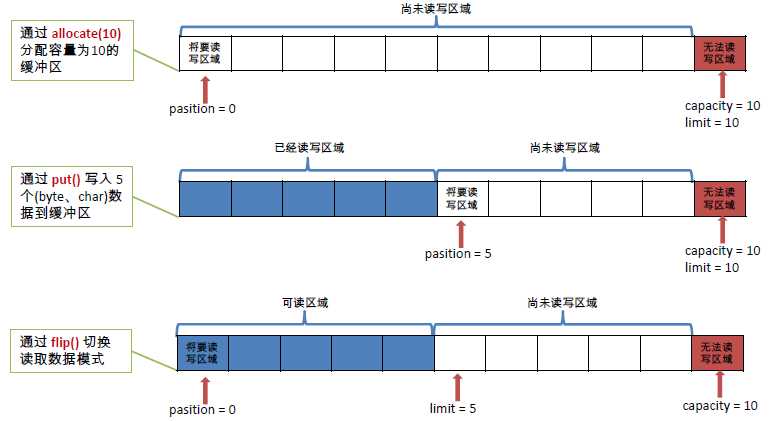
Buffer 的常用方法
方法/描述
Bufferclear()
清空缓冲区并返回对缓冲区的引用
Buffer flip()
将缓冲区的界限设置为当前位置,并将当前位置充值为0
int capacity()
返回Buffer 的capacity大小
boolean hasRemaining()
判断缓冲区中是否还有元素
int limit()
返回Buffer 的界限(limit) 的位置
Bufferlimit(int n)
将设置缓冲区界限为n, 并返回一个具有新limit 的缓冲区对象
Buffer mark()
对缓冲区设置标记
int position()
返回缓冲区的当前位置position
Buffer position(int n)
将设置缓冲区的当前位置为n , 并返回修改后的Buffer 对象
int remaining()
返回position 和limit 之间的元素个数
Buffer reset()
将位置position 转到以前设置的mark 所在的位置
Buffer rewind()
将位置设为为0,取消设置的mark
Buffer 所有子类提供了两个用于数据操作的方法:get() 与put() 方法
获取Buffer 中的数据
get() :读取单个字节
get(byte[] dst):批量读取多个字节到dst 中
get(int index):读取指定索引位置的字节(不会移动position)
放入数据到Buffer 中
put(byte b):将给定单个字节写入缓冲区的当前位置
put(byte[] src):将src 中的字节写入缓冲区的当前位置
put(int index, byte b):将指定字节写入缓冲区的索引位置(不会移动position)
直接与非直接缓冲区
字节缓冲区要么是直接的,要么是非直接的。如果为直接字节缓冲区,则Java 虚拟机会尽最大努力直接在此缓冲区上执行本机I/O 操作。也就是说,在每次调用基础操作系统的一个本机I/O 操作之前(或之后),虚拟机都会尽量避免将缓冲区的内容复制到中间缓冲区中(或从中间缓冲区中复制内容)。
直接字节缓冲区可以通过调用此类的allocateDirect() 工厂方法来创建。此方法返回的缓冲区进行分配和取消分配所需成本通常高于非直接缓冲区。直接缓冲区的内容可以驻留在常规的垃圾回收堆之外,因此,它们对应用程序的内存需求量造成的影响可能并不明显。所以,建议将直接缓冲区主要分配给那些易受基础系统的本机I/O 操作影响的大型、持久的缓冲区。一般情况下,最好仅在直接缓冲区能在程序性能方面带来明显好处时分配它们。
直接字节缓冲区还可以通过FileChannel 的map() 方法将文件区域直接映射到内存中来创建。该方法返回MappedByteBuffer。Java 平台的实现有助于通过JNI 从本机代码创建直接字节缓冲区。如果以上这些缓冲区中的某个缓冲区实例指的是不可访问的内存区域,则试图访问该区域不会更改该缓冲区的内容,并且将会在访问期间或稍后的某个时间导致抛出不确定的异常。
字节缓冲区是直接缓冲区还是非直接缓冲区可通过调用其isDirect()方法来确定。提供此方法是为了能够在性能关键型代码中执行显式缓冲区管理。
非直接缓冲区
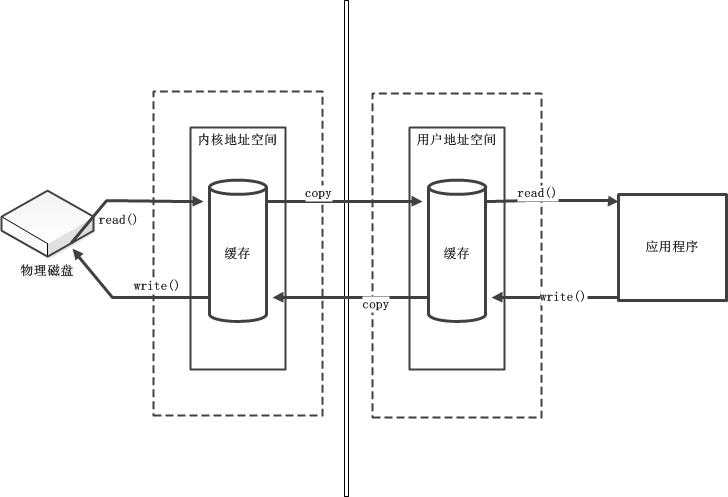
直接缓冲区
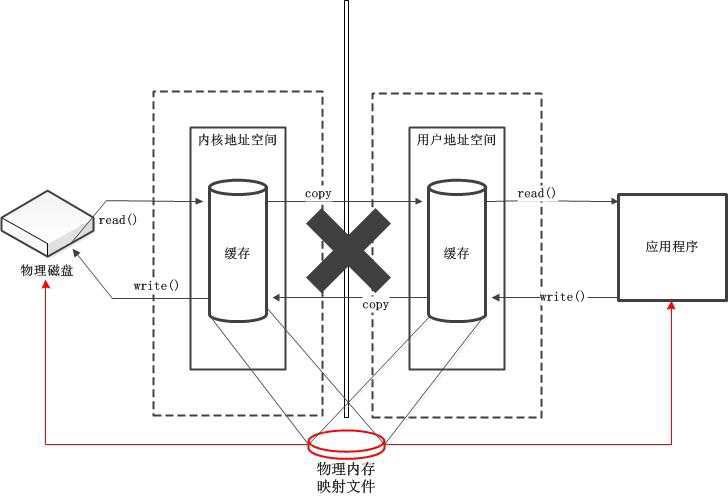
通道(Channel)
通道(Channel):由java.nio.channels 包定义的。Channel 表示IO 源与目标打开的连接。Channel 类似于传统的“流”。只不过Channel 本身不能直接访问数据,Channel 只能与Buffer 进行交互。
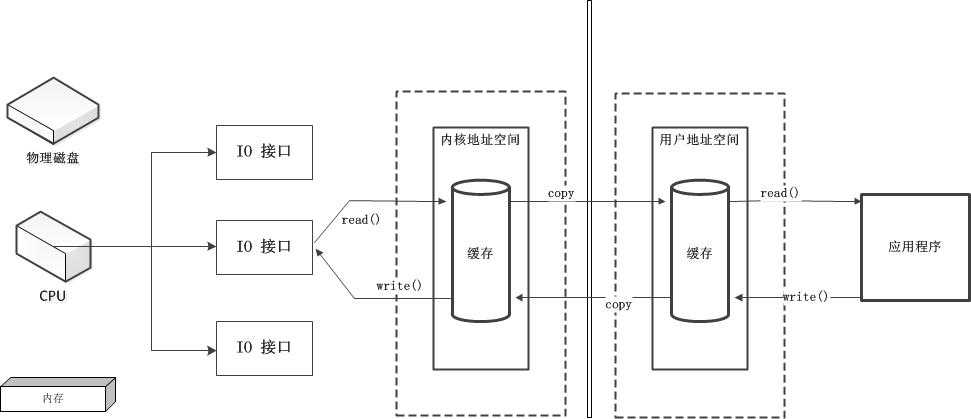
Java 为Channel 接口提供的最主要实现类如下:
- FileChannel:用于读取、写入、映射和操作文件的通道。
- DatagramChannel:通过UDP 读写网络中的数据通道。
- SocketChannel:通过TCP 读写网络中的数据。
- ServerSocketChannel:可以监听新进来的TCP 连接,对每一个新进来的连接都会创建一个SocketChannel。
获取通道的一种方式是对支持通道的对象调用getChannel() 方法。支持通道的类如下:
- FileInputStream
- FileOutputStream
- RandomAccessFile
- DatagramSocket
- Socket
- ServerSocket
获取通道的其他方式是使用Files 类的静态方法newByteChannel() 获取字节通道。或者通过通道的静态方法open() 打开并返回指定通道。
通道的数据传输
将Buffer 中数据写入Channel

从Channel 读取数据到Buffer

分散(Scatter)和聚集(Gather)
分散读取(Scattering Reads)是指从Channel 中读取的数据“分散”到多个Buffer 中。
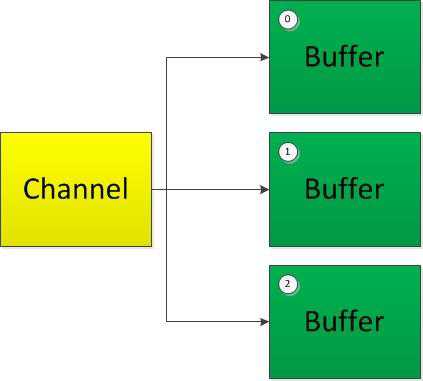
注意:按照缓冲区的顺序,从Channel 中读取的数据依次将Buffer 填满。
聚集写入(Gathering Writes)是指将多个Buffer 中的数据“聚集”到Channel。
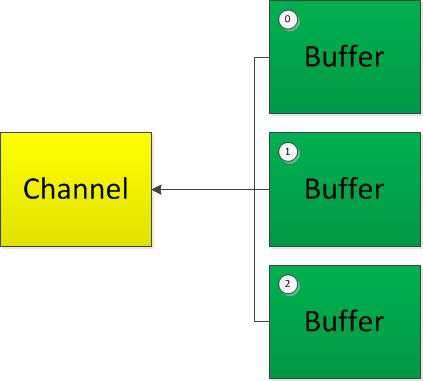
注意:按照缓冲区的顺序,写入position 和limit 之间的数据到Channel 。
transferFrom()将数据从源通道传输到其他Channel 中:

transferTo()将数据从源通道传输到其他Channel 中:

FileChannel 的常用方法
方法/描述
int read(ByteBuffer dst)
从Channel 中读取数据到ByteBuffer
long read(ByteBuffer[] dsts)
将Channel 中的数据“分散”到ByteBuffer[]
int write(ByteBuffer src)
将ByteBuffer 中的数据写入到Channel
long write(ByteBuffer[] srcs)
将ByteBuffer[] 中的数据“聚集”到Channel
long position()
返回此通道的文件位置
FileChannel position(long p)
设置此通道的文件位置
long size()
返回此通道的文件的当前大小
FileChannel truncate(long s)
将此通道的文件截取为给定大小
void force(boolean metaData)
强制将所有对此通道的文件更新写入到存储设备中
代码分析
TestBuffer类
package com.atguigu.nio; import java.nio.ByteBuffer; import org.junit.Test; /* * 一、缓冲区(Buffer):在 Java NIO 中负责数据的存取。缓冲区就是数组。用于存储不同数据类型的数据 * * 根据数据类型不同(boolean 除外),提供了相应类型的缓冲区: * ByteBuffer * CharBuffer * ShortBuffer * IntBuffer * LongBuffer * FloatBuffer * DoubleBuffer * * 上述缓冲区的管理方式几乎一致,通过 allocate() 获取缓冲区 * * 二、缓冲区存取数据的两个核心方法: * put() : 存入数据到缓冲区中 * get() : 获取缓冲区中的数据 * * 三、缓冲区中的四个核心属性: * capacity : 容量,表示缓冲区中最大存储数据的容量。一旦声明不能改变。 * limit : 界限,表示缓冲区中可以操作数据的大小。(limit 后数据不能进行读写) * position : 位置,表示缓冲区中正在操作数据的位置。 * * mark : 标记,表示记录当前 position 的位置。可以通过 reset() 恢复到 mark 的位置 * * 0 <= mark <= position <= limit <= capacity * * 四、直接缓冲区与非直接缓冲区: * 非直接缓冲区:通过 allocate() 方法分配缓冲区,将缓冲区建立在 JVM 的内存中 * 直接缓冲区:通过 allocateDirect() 方法分配直接缓冲区,将缓冲区建立在物理内存中。可以提高效率 */ public class TestBuffer { /** * 测试直接缓冲区,allocateDirect, isDirect */ @Test public void test3(){ //分配直接缓冲区 ByteBuffer buf = ByteBuffer.allocateDirect(1024); System.out.println(buf.isDirect()); } /** * 测试常用方法:mark, reset, hasRemaining, remaining */ @Test public void test2(){ String str = "abcde"; ByteBuffer buf = ByteBuffer.allocate(1024); buf.put(str.getBytes()); buf.flip(); byte[] dst = new byte[buf.limit()]; buf.get(dst, 0, 2); System.out.println(new String(dst, 0, 2)); System.out.println(buf.position()); //mark() : 标记 buf.mark(); buf.get(dst, 2, 2); System.out.println(new String(dst, 2, 2)); System.out.println(buf.position()); //reset() : 恢复到 mark 的位置 buf.reset(); System.out.println(buf.position()); //判断缓冲区中是否还有剩余数据 if(buf.hasRemaining()){ //获取缓冲区中可以操作的数量 System.out.println(buf.remaining()); } } @Test /** * 测试常用方法:allocate, position, limit, capacity, put, get, flip, rewind, clear, */ public void test1(){ String str = "abcde"; //1. 分配一个指定大小的缓冲区 ByteBuffer buf = ByteBuffer.allocate(1024); System.out.println("-----------------allocate()----------------"); System.out.println(buf.position()); System.out.println(buf.limit()); System.out.println(buf.capacity()); //2. 利用 put() 存入数据到缓冲区中 buf.put(str.getBytes()); System.out.println("-----------------put()----------------"); System.out.println(buf.position()); System.out.println(buf.limit()); System.out.println(buf.capacity()); //3. 切换读取数据模式,limit = position, position=0 buf.flip(); System.out.println("-----------------flip()----------------"); System.out.println(buf.position()); System.out.println(buf.limit()); System.out.println(buf.capacity()); //4. 利用 get() 读取缓冲区中的数据 byte[] dst = new byte[buf.limit()]; buf.get(dst); System.out.println(new String(dst, 0, dst.length)); System.out.println("-----------------get()----------------"); System.out.println(buf.position()); System.out.println(buf.limit()); System.out.println(buf.capacity()); //5. rewind() : 可重复读, position = 0 buf.rewind(); System.out.println("-----------------rewind()----------------"); System.out.println(buf.position()); System.out.println(buf.limit()); System.out.println(buf.capacity()); //6. clear() : 清空缓冲区. 但是缓冲区中的数据依然存在,但是处于“被遗忘”状态, position=0, limit = capacity buf.clear(); System.out.println("-----------------clear()----------------"); System.out.println(buf.position()); System.out.println(buf.limit()); System.out.println(buf.capacity()); System.out.println((char)buf.get()); } }
TestChannel类
package com.atguigu.nio; import java.io.FileInputStream; import java.io.FileOutputStream; import java.io.IOException; import java.io.RandomAccessFile; import java.nio.ByteBuffer; import java.nio.CharBuffer; import java.nio.MappedByteBuffer; import java.nio.channels.FileChannel; import java.nio.channels.FileChannel.MapMode; import java.nio.charset.CharacterCodingException; import java.nio.charset.Charset; import java.nio.charset.CharsetDecoder; import java.nio.charset.CharsetEncoder; import java.nio.file.Paths; import java.nio.file.StandardOpenOption; import java.util.Map; import java.util.Map.Entry; import java.util.Set; import org.junit.Test; /* * 一、通道(Channel):用于源节点与目标节点的连接。在 Java NIO 中负责缓冲区中数据的传输。Channel 本身不存储数据,因此需要配合缓冲区进行传输。 * * 二、通道的主要实现类 * java.nio.channels.Channel 接口: * |--FileChannel * |--SocketChannel * |--ServerSocketChannel * |--DatagramChannel * * 三、获取通道 * 1. Java 针对支持通道的类提供了 getChannel() 方法 * 本地 IO: * FileInputStream/FileOutputStream * RandomAccessFile * * 网络IO: * Socket * ServerSocket * DatagramSocket * * 2. 在 JDK 1.7 中的 NIO.2 针对各个通道提供了静态方法 open() * 3. 在 JDK 1.7 中的 NIO.2 的 Files 工具类的 newByteChannel() * * 四、通道之间的数据传输 * transferFrom() * transferTo() * * 五、分散(Scatter)与聚集(Gather) * 分散读取(Scattering Reads):将通道中的数据分散到多个缓冲区中 * 聚集写入(Gathering Writes):将多个缓冲区中的数据聚集到通道中 * * 六、字符集:Charset * 编码:字符串 -> 字节数组 * 解码:字节数组 -> 字符串 * */ /** * 关于网络间通道和内存映射文件处理大文件的内容查看相关资料 * @author Administrator * */ public class TestChannel { //字符编解码forName, encode, decode @Test public void test6() throws IOException{ Charset cs1 = Charset.forName("GBK"); //获取编码器 CharsetEncoder ce = cs1.newEncoder(); //获取解码器 CharsetDecoder cd = cs1.newDecoder(); CharBuffer cBuf = CharBuffer.allocate(1024); cBuf.put("尚硅谷威武!"); cBuf.flip(); //编码 ByteBuffer bBuf = ce.encode(cBuf); for (int i = 0; i < 12; i++) { System.out.println(bBuf.get()); } //解码 bBuf.flip(); CharBuffer cBuf2 = cd.decode(bBuf); System.out.println(cBuf2.toString()); System.out.println("------------------------------------------------------"); Charset cs2 = Charset.forName("GBK"); bBuf.flip(); CharBuffer cBuf3 = cs2.decode(bBuf); System.out.println(cBuf3.toString()); } /** * 获取所有可用字符集 */ @Test public void test5(){ Map<String, Charset> map = Charset.availableCharsets(); Set<Entry<String, Charset>> set = map.entrySet(); for (Entry<String, Charset> entry : set) { System.out.println(entry.getKey() + "=" + entry.getValue()); } } //分散和聚集,将通道数据读入多个缓冲,再从多个缓冲读取数据写入通道 @Test public void test4() throws IOException{ RandomAccessFile raf1 = new RandomAccessFile("1.txt", "rw"); //1. 获取通道 FileChannel channel1 = raf1.getChannel(); //2. 分配指定大小的缓冲区 ByteBuffer buf1 = ByteBuffer.allocate(100); ByteBuffer buf2 = ByteBuffer.allocate(1024); //3. 分散读取 ByteBuffer[] bufs = {buf1, buf2}; channel1.read(bufs); for (ByteBuffer byteBuffer : bufs) { byteBuffer.flip(); } System.out.println(new String(bufs[0].array(), 0, bufs[0].limit())); System.out.println("-----------------"); System.out.println(new String(bufs[1].array(), 0, bufs[1].limit())); //4. 聚集写入 RandomAccessFile raf2 = new RandomAccessFile("2.txt", "rw"); FileChannel channel2 = raf2.getChannel(); channel2.write(bufs); } //通道之间的数据传输(直接缓冲区),不借助缓冲,直接在通道间传输数据 @Test public void test3() throws IOException{ FileChannel inChannel = FileChannel.open(Paths.get("d:/1.mkv"), StandardOpenOption.READ); FileChannel outChannel = FileChannel.open(Paths.get("d:/2.mkv"), StandardOpenOption.WRITE, StandardOpenOption.READ, StandardOpenOption.CREATE); // inChannel.transferTo(0, inChannel.size(), outChannel); outChannel.transferFrom(inChannel, 0, inChannel.size()); inChannel.close(); outChannel.close(); } //使用直接缓冲区完成文件的复制(内存映射文件):通过通道映射内存映射文件 @Test public void test2() throws IOException{//2127-1902-1777 long start = System.currentTimeMillis(); FileChannel inChannel = FileChannel.open(Paths.get("d:/1.mkv"), StandardOpenOption.READ); FileChannel outChannel = FileChannel.open(Paths.get("d:/2.mkv"), StandardOpenOption.WRITE, StandardOpenOption.READ, StandardOpenOption.CREATE); //内存映射文件 MappedByteBuffer inMappedBuf = inChannel.map(MapMode.READ_ONLY, 0, inChannel.size()); MappedByteBuffer outMappedBuf = outChannel.map(MapMode.READ_WRITE, 0, inChannel.size()); //直接对缓冲区进行数据的读写操作 byte[] dst = new byte[inMappedBuf.limit()]; inMappedBuf.get(dst); outMappedBuf.put(dst); inChannel.close(); outChannel.close(); long end = System.currentTimeMillis(); System.out.println("耗费时间为:" + (end - start)); } //利用通道完成文件的复制(非直接缓冲区):通过文件输入输出流得到通道,通过缓冲作为中介传输通道中的数据, // 类似于输入输出流和字节数组 @Test public void test1(){//10874-10953 long start = System.currentTimeMillis(); FileInputStream fis = null; FileOutputStream fos = null; //①获取通道 FileChannel inChannel = null; FileChannel outChannel = null; try { fis = new FileInputStream("d:/1.mkv"); fos = new FileOutputStream("d:/2.mkv"); inChannel = fis.getChannel(); outChannel = fos.getChannel(); //②分配指定大小的缓冲区 ByteBuffer buf = ByteBuffer.allocate(1024); //③将通道中的数据存入缓冲区中 while(inChannel.read(buf) != -1){ buf.flip(); //切换读取数据的模式 //④将缓冲区中的数据写入通道中 outChannel.write(buf); buf.clear(); //清空缓冲区 } } catch (IOException e) { e.printStackTrace(); } finally { if(outChannel != null){ try { outChannel.close(); } catch (IOException e) { e.printStackTrace(); } } if(inChannel != null){ try { inChannel.close(); } catch (IOException e) { e.printStackTrace(); } } if(fos != null){ try { fos.close(); } catch (IOException e) { e.printStackTrace(); } } if(fis != null){ try { fis.close(); } catch (IOException e) { e.printStackTrace(); } } } long end = System.currentTimeMillis(); System.out.println("耗费时间为:" + (end - start)); } }
以上是关于JAVA NIO学习记录1-buffer和channel的主要内容,如果未能解决你的问题,请参考以下文章